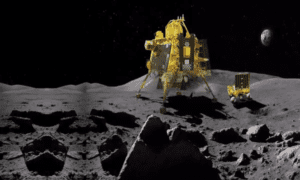The Indian Space Research Organisation (ISRO) successfully landed the Chandrayaan-3 lander on the Moon’s south pole on today (Wednesday, August 23, 2023), at 18:03 IST. This is a major milestone for India, as it is the first country to land a spacecraft on the lunar south pole. It is also the fourth country to successfully land a spacecraft on the Moon, after the United States, the Soviet Union, and China.

In a triumphant achievement, Chandrayaan-3 has gracefully touched down on the lunar surface today at 18:03 IST. This momentous event marks a proud milestone for the Indian Space Research Organization (ISRO) and the global space community. The successful landing is not only a testament to ISRO’s dedication and expertise but also a significant step in the annals of space exploration.
This accomplishment holds profound significance as Chandrayaan-3 becomes the first mission to land on the lunar south pole, a region rich in scientific intrigue and potential discoveries. By achieving a soft landing on the moon’s surface, India has now become the fourth nation in the world to achieve this remarkable feat.
The culmination of meticulous planning, cutting-edge technology, and the dedication of countless individuals has led to this historic success. Chandrayaan-3’s journey represents the collective effort of scientists, engineers, researchers, and space enthusiasts who have worked tirelessly to push the boundaries of human knowledge and exploration.

As the spacecraft gently touched down on the lunar surface, it resembles a bird gracefully alighting on the moon, symbolizing the harmony between human ingenuity and the vast cosmic expanse. This achievement not only cements India’s position in the global space arena but also paves the way for future lunar missions that could unlock new insights about our celestial neighbor.
The success of Chandrayaan-3 reaffirms ISRO’s commitment to advancing space technology and exploration, inspiring generations to come. It serves as a shining example of what humanity can achieve when united by a common goal and driven by the pursuit of knowledge.
This historic milestone is not only a moment of pride for ISRO but for all Indians and space enthusiasts worldwide. Chandrayaan-3’s soft landing on the lunar surface opens the door to a new era of lunar exploration and scientific discovery, showcasing the limitless possibilities that lie ahead in our journey through the cosmos.

The Chandrayaan-3 mission was launched on July 14, 2023, from the Satish Dhawan Space Centre in Sriharikota, India. The lander, named Vikram, and the rover, named Pragyan, were carried to the Moon by the Propulsion module.
The Vikram lander touched down on the Moon’s south pole at 18:03 IST on August 23, 2023. The landing was confirmed by ISRO officials, who said that the lander was in good health and that the rover was also in good health.

The Chandrayaan-3 mission is expected to conduct a variety of scientific experiments on the Moon’s south pole. The rover will explore the lunar surface and collect samples of rocks and soil. The lander will also conduct experiments to study the Moon’s atmosphere and geology.

- Significance of the Landing
The landing of Chandrayaan-3 on the Moon’s south pole is significant for a number of reasons. First, it is the first time that a spacecraft has landed in this region of the Moon. The south pole is thought to be rich in water ice, which is a valuable resource for future human exploration. Second, the landing of Chandrayaan-3 makes India the fourth country to successfully land a spacecraft on the Moon. This is a major milestone for the Indian space program and a testament to the country’s growing capabilities. Third, the landing of Chandrayaan-3 will allow scientists to conduct a variety of experiments on the Moon’s south pole. These experiments will help us to better understand the Moon’s history and geology, and they will also help us to plan future missions to the Moon.

- Future of the Chandrayaan-3 Mission
The Chandrayaan-3 mission is expected to 14 days but if temperature issues overcome and sustain then work for one year. During this time, the rover will explore the lunar surface and collect samples of rocks and soil. The lander will also conduct experiments to study the Moon’s atmosphere and geology.
After 14 days if possible one year, the Chandrayaan-3 mission will come to an end. However, the data and samples collected by the mission will continue to be analyzed by scientists for many years to come. This data will help us to better understand the Moon and its history, and it will also pave the way for future missions to the Moon and beyond.

The successful landing of Chandrayaan-3 is a major milestone for India and for the entire scientific community. It is a testament to the hard work and dedication of the ISRO team. This mission will help us to better understand the Moon and its history, and it will pave the way for future missions to the Moon and beyond.
